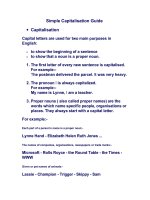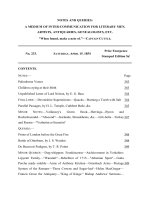- Trang chủ >>
- Đề thi >>
- THPT Quốc Gia
s2026 notes
Bạn đang xem bản rút gọn của tài liệu. Xem và tải ngay bản đầy đủ của tài liệu tại đây (277.19 KB, 13 trang )
STUDY NOTES
EPISODE 26: GENERAL TASK WRITING
WRITING TASK 1, GENERAL TRAINING MODULE
The instructions given for Task 1, General
Training Writing require a letter in response
to a problem or issue outlined in the test
question.
The candidate must address all the bullet
points listed in the question.
One of the key skills required for this task is
the ability to fully respond to all these points.
The letter might be seeking or providing
information, complaining about a service,
giving directions or relating a series of events.
STUDY TIPS
It is necessary in Task 1, General
Training Writing, to address all
the three bullet points listed in the
question.
Develop your skills in organising
a letter in response to information
supplied in these bullet points,
including as much relevant
information as possible, using a
variety of sentence types, and
appropriate vocabulary. Always
check your spelling.
What do I have to do?
Writing Task 1, General Training Module requires the test candidate to:
•
write a short letter of 150 words minimum in response to information supplied
in the test question, taking approximately 20 minutes
•
address all bullet points in the question
•
select the appropriate tone – semi-formal to formal
What type of letter might be required?
We can identify several purposes for writing letters:
•
•
•
•
•
•
•
Giving / requesting information
Giving instructions, including directions
Relating an event
Giving good/bad news
Complaining – a mild or strong complaint
Describing
Advising and suggesting
Some letters can include a few of these purposes at the same time.
On the follow page are some examples of letters with the purposes listed:
Page 1 of 12
Type of Letter
Examples
Giving information
travel plans; arrival details; what to see and do on holidays;
contents of a course of study
Requesting information
course information; library hours and borrowers’ rights;
timetable information; information about classes and
subjects, or examinations, how to prepare and what to bring
to the test
Giving instructions
how to get to your house; how to use or operate a tool or
machine; how to use the public transport system in your
home town
Relating an event
an incident or accident; a memorable event; a holiday or
excursion; a happy event (a meal with friends, meeting an
old friend); a news event
Giving good news
travelling to visit a friend/family; news about a happy event
(a wedding, anniversary, school results, graduation);
availability of a new service
Giving bad news
having to cancel an appointment; decided to discontinue a
course; cannot attend an event (wedding, party, holiday
visit); increase in the cost or availability of a service
Complaining
service in a restaurant; public transport service; noise in
local area (industrial, building works, neighbours, nightspot,
traffic); cost of a course; teacher on a course; content of a
course of study; parks and gardens in your local area;
places for your children to play
Describing
describing lost property; a friend; a place; a favourite holiday
destination; your favourite place; your apartment or house;
your family; your teacher; your school; your favourite shop
or restaurant
Advising and suggesting
giving advice to a friend on what to study or choosing a
career; to parents on dealing with a difficult child; to a friend
who is thinking of emigrating; what to see and do on
holidays, in a new country or city; what to order in a
restaurant; what to do at night for entertainment
Page 2 of 12
What does the question look like?
The layout of an IELTS General Training task 1 Writing question is standard. All
questions look the same, but of course each question is different – in terms of the
topic and the particular purpose of the letter.
Example: WRITING TASK 1
You should spend about 20 minutes on this task.
You are visiting another country to visit a family member you have
never met before. This relative has offered to meet you at the airport.
Write a letter to this relative informing him/her of your arrival details and
how to recognise you. In your letter
introduce yourself and say why you are writing
give your arrival details
describe what you look like, so your relative will recognise you
Write at least 150 words.
You do NOT need to write any address.
Begin your letter as follows:
Dear _________ ,
NB: This letter requires the giving of information (“give your arrival details”) and a
description (“describe what you look like”).
To summarise:
you should spend 20 minutes on the task
you should address all the information in the task
you must write at least 150 words
you do NOT need to write any address
you should begin with “Dear ______,”
Page 3 of 12
How are letters organised in English?
Letters in English are structured in a particular way. They consist of several parts:
1.
2.
3.
4.
The Greeting, or salutation
The Body
The Conclusion – final words to conclude the letter
The Closing salutation and personal signature
Greeting
Dear ______________ ,
Body
1. introduce yourself and say why you are writing
2. your arrival details
3. what you look like, so your relative will recognise you
Final words to close the letter.
Conclusion
of the letter
Closing
salutation
Regards
(Yours sincerely for a formal letter
or Yours faithfully for a business letter) *
* NB “Yours faithfully” is used in British and Australian English. It is not commonly
used in North American English, where usually “Yours sincerely”, is used for formal
letters.
In IELTS, the contents of the body of the letter are described or dictated by the
question. The task tells you why you are writing and what you are writing about:
Why you are writing: “You are visiting another country to visit a family
member you have never met before. This relative
has offered to meet you at the airport.
Write a letter to this relative informing him/her of
your arrival details and how to recognise you."
Page 4 of 12
What you are writing about is set out in the three bullet points that follow the reason
statement (for instance):
In your letter
introduce yourself and say why you are writing
give your arrival details
describe what you look like, so your relative will recognise you
The way the IELTS task question is constructed gives you the structure for your
letter.
This tells you that you should construct 3 body paragraphs, one for each bullet point.
Thus your letter should look something like this.
Greeting (Dear ……)
1. Introduce yourself and say why you are writing
Body
Purpose stated (I am writing ….)
2. Give your arrival details
3. Describe what you look like, so your relative will recognise
you
Conclusion Final remarks
of the letter
Closing
salutation
Regards
Signature
Page 5 of 12
What language choices do I have?
We write because we have a purpose. It is important to indicate at the beginning of a
letter what its purpose is – exactly why you are writing:
Type of Letter
Giving information
Requesting information
Giving instructions
Relating an event
Giving good news
Giving bad news
Complaining
Describing
Advising or suggesting
Purpose Statement
I am writing to advise that ….
I am writing to request information about ….
I am writing to explain how to ….
I have been asked to give details of the accident ….
I am very happy to tell you that….
I regret to inform ….
I am writing to complain about ….
I am writing to describe what I remember of the ….
I would like to offer some suggestions about ….
Functions
Giving information
Structures
It gives me great pleasure to be able to…
I am pleased to be able to…
I am happy to announce…
Please be advised/informed that…
I would like to inform you that…
Here is the information you required/requested/asked for.
Attached please find the information you required/requested/asked for.
Giving good news
Structures
I am delighted to be able to advise/tell/inform you that…
I am pleased to advise/tell/inform you that…
It gives me great pleasure to advise/tell/inform you that…
It gives me great pleasure to be able to advise/tell/inform you that…
I have some great/good/happy news to share with/tell you.
Giving bad news
Structures
I am sorry to say that…
I regret to advise/tell/inform you that…
Giving a reason
This is due to…
This is owing to…
This is because of…
Page 6 of 12
This is a result of…
Page 7 of 12
Requesting information
Polite
Request:
I would appreciate it if you could send me information on…
It would be appreciated if you could…
I would be (most) grateful if you could send me information on…
Could you please send/forward/supply information on…
Would you please send/forward/supply…
Would you be so kind as to…
Would you mind sending/forwarding/supplying me…
Please may I have information on…
May I have information on…
Please send/forward/supply information on…
Send/forward/supply information on…
Give me information on…
I want information on…
Impolite
Being explicit:
In particular, I need to know…
Actually I need information on…
The information I require is…
What I require/need/want is…
Giving instructions
Grammar
Imperatives:
put, turn, add, close, shut, remove, heat
don’t forget to, don’t touch, don’t open
Polite
Impolite
Please remember to clean the…
Please arrange to have the iron repaired.
Please have the car repaired by next Friday.
Please clean the…
I’d like you to clean the…
I want you to clean the…
Clean the…
Conditionals:
if… then…
unless… then
Eg: If the iron is broken, then please fix it.
Transition Signals:
first, second, third, then, next, after that, final, last
firstly, secondly, thirdly, finally, lastly
when, while, as
Eg:
Turn left when you reach the corner.
While beating the eggs, blend in the sugar.
Maintain speed as you turn the corner.
NB It is possible to replace an instruction with a polite request for action.
Example:
Please repair the iron. It is faulty.
(Polite instruction using an imperative verb)
I would like the iron repaired. It is faulty.
(Polite request using a modal verb)
Page 8 of 12
Complaining
When making a complaint there are sometimes a few parts to the message:
Announcing that you have a complaint to make
I am writing to complain about…
I would like to make a complaint about…
Unfortunately, there were some problems with…
Making a point
I should/would like to remind you that it is illegal to park a car in this place.
I should/would like to point out that it is illegal to smoke in public places.
I would like to draw your attention to the law banning smoking.
I hope it is not necessary to remind you that smoking is illegal in public places.
Warning
Unless something is done about this, I will be forced to take the matter to…
Unless you do something about this, I will have to…
If you do not do something about this, then I will have to…
Advising or making suggestions
You should/might…
Why don’t you…
You might like to…
Perhaps/maybe you could try…
Have you thought about…
What about doing/having/going/trying…
Why don’t you…
I suggest that you…
Apologising
I am extremely sorry that…
I humbly apologise for the trouble…*
I apologise for…
Please accept my apologies for what happened.
Please pass on my apologies to…
Give my apologies to…
I regret that…
I am sorry that…
* NB This is a very formal construction
Page 9 of 12
Politeness
Modal verbs are used in English for politeness.
May I…
Would it be possible to come at 8.30 and not 8.00?
Would you mind if I changed the meeting time?
Would you mind turning down your music – I can’t study.
Could I/you come at a later more convenient time.
Levels of Formality
Formality is achieved in English in several ways:
Vocabulary choices
Grammar choices
Language can be made more formal either by choosing more formal vocabulary or by
choosing more formal grammatical structures.
Vocabulary
1. Simple or common words are less formal than unusual or less frequently used
words. These simple words are usually short, monosyllabic words, whereas
more formal words tend to be longer, multi-syllabic words:
Informal
send
give
stop
want
happy
I am sorry
Formal
forward
provide
refrain from
require
grateful
I regret
2. Conjunctions
Informal
because of
and
but
if
Formal
owing to / due to / as a result of
furthermore, moreover
however
whether
Page 10 of 12
3. Phrasal Verbs
Informal (Phrasal Verb)
look into
think about
look back
pass on
go out
go in
get off
get on
Formal (Single Verb)
investigate
consider
reflect
forward
exit
enter
alight
board
4. Modal Verbs
Informal
I will be very happy if you can ….
I want to point out ….
Can you please ….
If you want ….
If you need ….
Why don’t you ….
You should take a train.
Formal
I would be very happy if you could….
I would like to point out ….
Could you please ….
If you would like ….
Should you require ….
You might like to ….
It would be better for you to take a train.
Grammar
1. Active/Passive Voice
Informal (Active Voice)
Unless you do something about ….
If you don’t do something about …
I will have to take ….
I would appreciate it if ….
This caused the fire to break out.
Formal (Passive Voice)
Unless something is done about ….
If something is not done about ….
I will be forced to take ….
It would be appreciated if ….
The fire was caused by ….
2. Instructions and Polite Requests
Informal (Direct Instruction)
Please clean all the windows.
Please make a reservation in my
name.
Formal (Indirect Request)
I would like all the windows cleaned.
I would like a reservation made in my name.
What is the examiner looking for?
For information on the criteria used by IELTS examiners when marking an essay for
Task 1, go to www.ielts.org
Page 11 of 12
There are four criteria which IELTS examiners refer to:
1. Task Response
2. Coherence and Cohesion
3. Lexical Resource
4. Grammatical Range and Accuracy
What do these criteria mean?
1. Task Response
This criteria is a measure of your ability to construct a letter which:
1. addresses fully all aspects identified in the bullet points listed in the test
question, using a minimum of 150 words, in the time allowed (20 minutes is
recommended). The content must be relevant and accurate.
2. is organised in a particular way with:
i.
a salutation or greeting (Dear Sir or Madam))
ii.
a clear statement of purpose (reason for writing), and
iii.
clear paragraphs addressing each bullet point, and finally
iv.
an appropriate closing (Yours faithfully, Yours sincerely, All the
best, or Regards).
3. adopts an appropriate tone. Level of formality is achieved in the use of:
i.
polite phrases
ii.
topic choice – what we talk about in formal or informal settings
iii.
more formal vocabulary, fewer phrasal verbs, and no slang
iv.
punctuation
Example: Postcards are punctuated very loosely and contain many abbreviations and
slang terms, as well as many phrasal verbs, and maybe some amusing topics or
anecdotes:
“Paris nightlife is fabulous! Oohlala! Wowee! Can’t wait to show you the
happy snaps! Boy! – talk about hot! hot! hot!”.
2. Coherence and Cohesion
It is important that your letter is easy to follow – that it is logically organised, from
sentence to sentence, and from the beginning to the end, from the opening
paragraph, to the closing. Information and ideas should be sequenced logically
through the letter so that it is easy for the reader, the examiner, to follow.
Coherence means logical organisation of information and ideas across the
whole letter and is achieved through:
i.
clear use of paragraphs, from the opening paragraph which
clearly states the purpose of the letter, to the closing paragraph.
Each paragraph should clearly address a single bullet point.
ii.
transition signals and conjunctions, time words and phrases,
and discourse markers.
Page 12 of 12
Cohesion means the organisation of language at the sentence level, inside and
between sentences. This is achieved through:
i.
correct word order
ii.
agreement of subject and verb (in number and case);
noun and pronoun agreement (number, case and
gender)
iii.
correct use of articles (a/an and the)
iv.
choice and sequence of tenses, and
v.
correct use of conjunctions
3. Lexical Resource
Here the examiner looks at your vocabulary and your ability to communicate
meaning precisely and accurately. Do you have the vocabulary to carry out the
requirements of the task? Lexical resource means:
i.
ii.
iii.
iv.
v.
extensive vocabulary to enable you to easily write a
letter in response to the instructions in the task question. These
questions will be on a broad range of topics.
command of word forms. There should be a degree of
flexibility in your use of language, so that you can move
smoothly from adjective/noun constructions to verb/adverb
constructions. You should have a command of word forms
(instructive/instructor/instruction/instruct/ instructively etc)
ability to paraphrase
an understanding of usage (collocation – “high building” or
“tall building”; “beautiful man” or “handsome man”; “white and
black” or “black and white”?)
spelling
4. Grammatical Range and Accuracy
This criteria includes:
i.
ii.
iii.
iv.
range of sentence types – simple, compound and complex
sentences. Complex sentences contain a dependent clause
introduced by a subordinating conjunction, relative pronoun or
participle.
range of structures:
•
active/passive voice
•
cause/effect language (“as a result the holiday was ruined”,
“the fault caused a fuse in the power board and a fire broke
out…”)
•
reported speech (“I was told that ….”, “the salesman assured
me that ….”, “I promise/assure you that unless something is
….”)
•
conditionals (“íf something is not done ….”)
level of error (number of mistakes)
punctuation
Page 13 of 12









